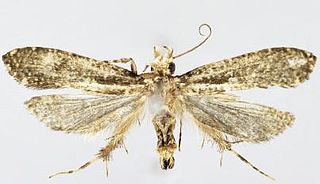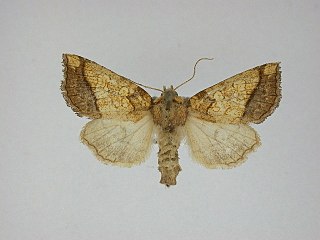
Livistona mariae, also known as the central Australian or red cabbage palm, is a species of flowering plant in the family Arecaceae.
Tinissa cinerascens is a moth of the family Tineidae. It is found in New Guinea and surrounding islands and from the coasts of Queensland, Australia.

Persoonia rigida, commonly known as the rigid-, hairy- or stiff geebung, is a species of flowering plant in the family Proteaceae and is endemic to south-eastern Australia. It is an erect to low-lying shrub with hairy young branchlets, lance-shaped to spatula-shaped leaves that are hairy when young, and yellow flowers borne in groups of up to twenty on a rachis up to 90 mm (3.5 in) long that continues to grow after flowering.

Tinissa is a genus of the fungus moth family (Tineidae). Therein, it belongs to the subfamily Scardiinae.

Tinissa indica is a moth of the family Tineidae. It is found in China, Taiwan, India, Sikkim and Bhutan.

Tinissa insularia is a moth of the family Tineidae. It is found in China (Yunnan), Malaysia, Borneo, Indonesia, the Philippines, New Guinea and the Solomon Islands.

Tinissa apicimaculata is a moth of the family Tineidae. It is found in Guangxi, China.

Tinissa conchata is a moth of the family Tineidae. It is found in China.

Tinissa connata is a moth of the family Tineidae. It is found in China.

Tinissa leguminella is a moth of the family Tineidae. It is found in Yunnan, China.

Tinissa spirella is a moth of the family Tineidae. It is found in Sichuan, China.
Tinissa cultellata is a moth of the family Tineidae. It was described by László Anthony Gozmány and Lajos Vári in 1973. It is found in Uganda.
Tinissa polysema is a moth of the family Tineidae. It was described by Zagulajev in 1972. It is found on Java.
Tinissa transversella is a moth of the family Tineidae. It was described by Francis Walker in 1864. It is found on Borneo.
Girida rigida is a moth in the family Geometridae first described by Charles Swinhoe in 1892. It is found from the Ryukyu Islands through tropical and subtropical south-east Asia to New Caledonia. Records for eastern Africa refer to Girida sporadica, which was promoted to species rank in 2012.
Scolioplecta rigida is a species of moth of the family Tortricidae. It is found in Western Australia, Australia.
Aroga rigidae is a moth of the family Gelechiidae. It is found in North America, where it has been recorded from Washington.

The Scardiinae are a subfamily of moth of the family Tineidae. Scardiinae are fungivorous and are characterised by larval features and lack of gnathos.

Papaipema rigida, the rigid sunflower borer, is a species of cutworm or dart moth in the family Noctuidae. It is found in North America.
This page is based on this
Wikipedia article Text is available under the
CC BY-SA 4.0 license; additional terms may apply.
Images, videos and audio are available under their respective licenses.









